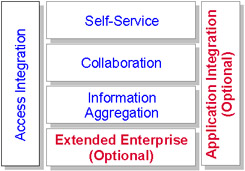2.2 The Portal composite pattern
2.2 The Portal composite pattern
Composite patterns represent commonly occurring combinations of Business patterns and Integration patterns to form higher level solutions. Composite patterns typically solve major portions of functionality within a solution.
The Business and Integration patterns that are identified as the building blocks or the more common patterns of the Portal composite pattern are as follows :
-
Access Integration pattern
-
Self-Service business pattern
-
Collaboration business pattern
-
Information Aggregation business pattern
Please note that based on your specific requirements, your building blocks of the Business and Integration patterns for your portal may vary from the Portal composite pattern. For example, you may find that you have use for the Extended Enterprise business pattern in addition to the ones we defined, or you may find that you only need the Access Integration, and Self-Services business patterns for your portal. Based on your specific requirements, this would then be defined as a Portal custom design.
The visual representation of the Portal composite pattern is shown in Figure 2-1.

Figure 2-1: Portal composite pattern showing mandatory patterns
For more details on the Portal composite pattern refer to the redbook, A Portal composite pattern Using WebSphere Portal V4.1 , SG24-6869.
2.2.1 Benefits
The Portal composite pattern is a combination of patterns, technologies and products. It allows for an understanding of the business and IT drivers that help an organization answer these questions:
-
Do I need a portal?
-
What can I achieve with a portal?
Once an organization has determined that it needs to aggregate information, target that information to specific users, analyze the usage of information, and collect and manage information, it can use a portal to handle these requirements. Consequently, using the Portal composite pattern will eventually lead to a choice of Application patterns and the subsequent combined Runtime pattern. This, in turn , will drive the creation of a portal architecture. Some specific benefits include:
-
A single aggregated view of content targeted to specific user types
-
Ability to analyze usage patterns to make marketing efforts more efficient
-
Ability to tailor the user interface to specific groups enabling a focus on cultural, language, and nationality -based differences
-
Single sign-on, allowing the user to "save time" and have access to information while lessening the requirements for direct interaction with the organization (saves money)
2.2.2 Limitations
The creation of a portal is a complex undertaking. It requires linking together various normally incompatible systems to provide a single view of the information in an enterprise. Although this of value to most organizations, it will require the following of an organization:
-
Organizational changes
-
Process changes
-
Restructuring of existing data sources
-
Rebuilding some existing applications to support available connectivity options
-
The detailed analysis of the various user groups that need to be supported (usually in much more detail than what currently exists)
A portal implementation assumes that there will be impacts in all of these areas.
EAN: 2147483647
Pages: 83
- Challenging the Unpredictable: Changeable Order Management Systems
- The Effects of an Enterprise Resource Planning System (ERP) Implementation on Job Characteristics – A Study using the Hackman and Oldham Job Characteristics Model
- Context Management of ERP Processes in Virtual Communities
- Intrinsic and Contextual Data Quality: The Effect of Media and Personal Involvement
- Healthcare Information: From Administrative to Practice Databases